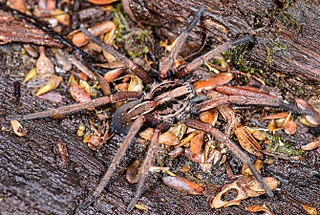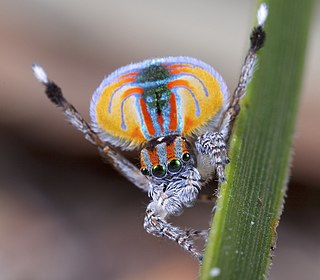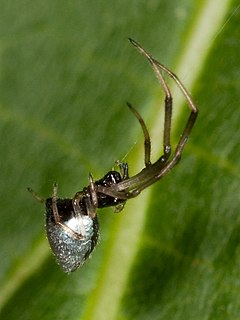
Miturgidae is a family of araneomorph spiders that includes nearly 170 species in 29 genera worldwide. First described by Eugène Simon in 1886, it has been substantially revised, including of previous family "Zoridae" as subfamily "Zorinae" and excluding the family "Xenoctenidae". Several genera have also been removed, such as the large genus Cheiracanthium, which was transferred to the Cheiracanthiidae.

Orb-weaver spiders or araneids are members of the spider family Araneidae. They are the most common group of builders of spiral wheel-shaped webs often found in gardens, fields and forest. "Orb" can in English mean "circular", hence the English name of the group. Araneids have eight similar eyes, hairy or spiny legs, and no stridulating organs.

Corinnidae is a family of araneomorph spiders, sometimes called corinnid sac spiders. The family, like other "clubionoid" families, has a confusing taxonomic history. Once it was a part of the large catch-all taxon Clubionidae, now very much smaller. The original members of the family are apparently similar only in that they have eight eyes arranged in two rows, conical anterior spinnerets that touch and are generally wandering predators that build silken retreats, or sacs, usually on plant terminals, between leaves, under bark or under rocks.

Ascyltus are a genus of jumping spiders in the family Salticidae that was first described by Ferdinand Anton Franz Karsch in 1878. As of 2019, this Genus contained 10 species. The Ascyltus spiders utilize their vision in courtship, hunting, and navigation. Ascyltus are typically large to medium sized Salticids and often move relatively slow. However, they are capable of agile jumps when moving, hunting, or to avoid predators. They have well developed book lungs and tracheal systems, and they are capable of utilizing both systems. Ascyltus have four pairs of eyes, with the anterior median pair being the most prominent. One distinguishable characteristic of the Ascyltus include their antero-lateral carapace, which is iridescently colored.

Maratus is a spider genus of the family Salticidae. These spiders are commonly referred to as peacock spiders due to the males' colorful and usually iridescent patterns on the upper surface of the abdomen often enhanced with lateral flaps or bristles, which they display during courtship. Females lack these bright colors, being cryptic in appearance. In at least one species, Maratus vespertilio, the expansion of the flaps also occurs during ritualised contests between males. The male display and courtship dance are complex, involving visual and vibratory signals.

Opisthoncus is a genus of South Pacific jumping spiders that was first described by Ludwig Carl Christian Koch in 1880. There are still many Australian species that have not yet been described.

Sandalodes is a genus of jumping spiders that was first described by Eugen von Keyserling in 1883. S. scopifer, a black spider with white markings, is a common species in eucalypt forests on the Darling Downs.

Servaea is a genus of jumping spiders that was first described by Eugène Louis Simon in 1888. S. murina females are about 8 millimetres (0.31 in) long.

Simaetha is a genus of Australasian jumping spiders that was first described by Tamerlan Thorell in 1881. They resemble members of Simaethula and Stertinius.

Zenodorus is a genus of the jumping spiders distributed from the Moluccas to Australia, including several islands of the Pacific. It was once considered a junior synonym of Omoedus, but this was later rejected. At least one species, Z. orbiculatus, specializes on hunting ants.

Argyrodes, also called dewdrop spiders, is a genus of comb-footed spiders that was first described by Eugène Louis Simon in 1864. They occur worldwide, and are best known for their kleptoparasitism. They can spin their own webs, but tend to invade and reside in their hosts' webs. This relationship can be commensal or even mutual if the dewdrop spider feeds on small trapped insects that are not eaten by the host. Some species can even prey upon the host.

Cyclosa, also called trashline orbweavers, is a genus of orb-weaver spiders first described by Anton Menge in 1866. Widely distributed worldwide, spiders of the genus Cyclosa build relatively small orb webs with a web decoration. The web decoration in Cyclosa spiders is often linear and includes prey remains and other debris, which probably serve to camouflage the spider. The name "Cyclosa" comes from Greek 'to move in a circle', referring to how it spins its web.

Hogna is a genus of wolf spiders with more than 200 described species. It is found on all continents except Antarctica.

Tetragnatha is a genus of long-jawed orb-weavers found all over the world. It was first described by Pierre André Latreille in 1804, and it contains hundreds of species. Most occur in the tropics and subtropics, and many can run over water. They are commonly called stretch spiders in reference to their elongated body form and their ability to hide on blades of grass or similar elongated substrates by stretching their front legs forward and the others behind them. The name Tetragnatha is derived from Greek, tetra- a numerical prefix referring to four and gnatha meaning "jaw". On the Hawaiian islands, a shift of cursorial behavior occurred long ago, when their ancestors first arrived on the island chain.

Arkys, also known as triangular spider or ambush spider, is a genus of Australian araneomorph spiders in the family Arkyidae, first described by Charles Athanase Walckenaer in 1837. They are often small, with a triangular shaped abdomen, and are found in Australia and some of its surrounding islands. They don't build webs, but can often be found on leaves and tips of flower heads. Their egg sacs are pinkish-orange and spherical, and are made late in the summer.

Argoctenus is a genus of South Pacific long-legged sac spiders first described by Ludwig Carl Christian Koch in 1878. They are found in Australia, New Zealand, and New Guinea. They resemble wolf spiders except for the narrowed carapace and the eye arrangement.

Arkyidae is a family of araneomorph spiders first described by Ludwig Carl Christian Koch in 1872 as a subfamily of Araneidae, and later elevated to a full family in 2017.

















